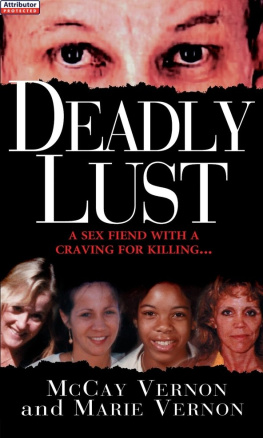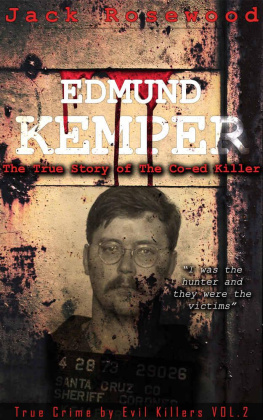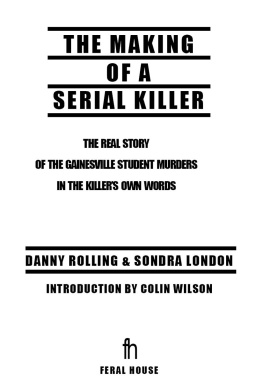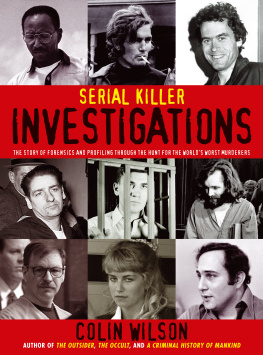ABOUT THE AUTHORS
McCay Vernon, Ph.D., is a psychologist whose career has concentrated on the fields of deafness and forensics. He is the author of seven books, over 300 articles, award-winning documentary films, and television productions in those fields. Although his path never crossed that of William Darrell Lindsey, Dr. Vernon attended the same high school, delivered the local paper to Lindseys family, and shared many acquaintances with the killer.
Marie Vernon is a freelance journalist whose columns, feature articles, and book reviews have appeared in such major newspapers as the Baltimore Sun, Cleveland Plain Dealer, Atlanta Journal-Constitution, Christian Science Monitor , and Florida-Times-Union. She is the author of Speaking of Our Past: A Narrative History of Owings Mills, Maryland.
The Vernons live near St. Augustine, Florida.
Afterword
Yet we have gone on living,
Living and partly living.
T.S. Eliot, Murder in the Cathedral
At the time of this writing, more than seventeen years have passed since Anita Stevenss murder. Even Lucy Raymers death is now nearly a decade in the past. Today, gravestones mark the final resting places of most of William Darrell Lindseys victims. The perpetrator himself is in prison.
Seemingly, this brings closure to a grievous period in St. Augustine history. But in a sense, there can be no finality in such situations. The families of the victims still live with the memory of the cruel death their loved ones endured.
In dealing with the segment of society that Lindsey and his victims inhabited, the authors were forced to present a picture of West Augustine as an ill-kempt, crime-ridden area. It should be noted that the majority of West Augustines inhabitants are not part of this underworld of crime and prostitution. Those outside that dark circle care deeply about their community and support efforts to improve it. The churches of West Augustine play a significant role, serving as a focus for community efforts to push for affordable housing, improved community services, and reduced crime.
Within the wider community there are also attempts to bring together St. Augustines racially diverse elements. Following a recent incident in which a black man died while being taken into police custody, Mayor George Gardner visited churches in West Augustine to listen to the black communitys comments and complaints about the tragedy.
At Crack Head Corner, a fence has been erected around the vacant purple building that once housed a car wash. The convenience store has been newly decorated with coats of bright red and yellow paint. Zs Fried Chicken is featured. A sign erected nearby advertises that THE AFRICAN AM ERICAN ARCHIVES AND MUSEUM is a work in progress. Some homes along West King Street have also been given a fresh coat of paint.
But progress in the area comes with painful slowness. As recently as January 2003, the St. Augustine Record found it newsworthy that trash cans had been installed on West King Street, even though the rest of downtown Augustine already has over 190 such receptacles. A suggestion from a bicycle-patrol police officer brought about the improvement.
Victims advocate Mary Alice Colson, now retired, feels that great strides have been made in Lincolnville toward eliminating criminal activity in that neighborhood. Formerly an area where much of the drug activity took place, it has undergone drastic change in recent years. Buyers seeking in-town locations have bought up many of the old Victorian houses in the area and remodeled them, causing real estate prices in the area to rise significantly. Intense efforts by residents to take the area back from the drug dealers and prostitutes are slowly but surely paying off.
The Pic n Save, mentioned frequently in this story as a rendezvous for drug pushers and prostitutes, has been turned into what is advertised as St. Augustines Only 100% Climate-Controlled Self-Storage Facility. A real estate office occupies part of the building.
Fabian Stiles, one of the men investigated for Cheryl Lucass murder, is back in jail, charged with distribution of drugs. He was turned in by a prostitute to whom he had sold crack. Dallas Porter, a prime suspect in Cheryls murder, left St. Augustine. Several years later he died in a house fire of unknown origin.
Several of the suspects, witnesses, and informants interviewed by detectives during the course of the investigation have died of AIDS or drug overdoses. A few have drifted off to other communities, while others are still on the streets.
For Detectives Frank Welborn and John Harrison, their collaboration did not end with Lindseys imprisonment. Despite living six hundred miles apart, they have found and shared many interests in common. They and their families have become close friends and visit one another whenever possible. As a result of his excellent police work in the Lindsey case, Frank Welborn has been promoted to the rank of lieutenant.
Bill Haggerty, the profiler who assisted in the case, is now retired from the FBI and has his own profiling business.
In April 2004 Sheriff Neil Perry announced his retirement from the elective position he has held for over two decades, saying he wants to travel and spend more time with his family. While not closing any doors to a future in politics, Perry insists that for the time being he is content to look back on a forty-year career in law enforcement and enjoy his home and family.
When asked if modern law-enforcement techniques could have brought Lindsey to justice sooner, Sheriff Neil Perry responded, Even with todays technology, more sophisticated law-enforcement techniques, and our increased personnel resources, we could not have done better in locating the killer. Bill left us with so little in the form of evidence. And nothing he had done previously would have provided a DNA match. Even the twenty-two handgun he used in killing Connie is almost impossible to identify through matching the bullet.
Detective Jennifer Ponce, whose actions were critical in helping to break down Lindseys defenses, is no longer in police work. She is now employed by a local insurance agency. As a single mother with two young daughters, she felt she owed it to them to take a job less demanding of her time and energy.
She admits that after the thrill of helping to track down a serial killer, it has been hard to find that kind of passion for other work, especially since, during her years in law enforcement, not only her working life but her social life as well centered on her work and her police colleagues. She credits her experience in law enforcement with having introduced her to a world she would never otherwise have known. Ive been through experiences ordinary people will never see or think about, she says. When youre in law enforcement, she says, its like being in a cubicle. That is your whole world.
Now that shes out of the cubicle, she finds it difficult to choose the direction in which she wishes to go. I always wanted to be a boat captain like my grandfather, she says. Do you think its too late for that?
On February 21, 2003, Kay Blaisdell Mora, the psychic known as Kaimora, died in Gainesville, Florida, at age seventy-four.
Retired victims advocate Mary Alice Colson stays in touch with the victims families, even though she has now officially stepped down from her law enforcement duties. When she learns of a familys need, she uses her influence with various civic organizations to arrange financial aid for such items as purchase of school materials and Christmas gifts for children. At his retirement Sheriff Perry credited her with true compassion and a commitment to her job of helping others. Colson has also been instrumental in the establishment of a shelter for battered women in St. Augustine. The Betty Griffin House, where women and their children find shelter and help, is named for Mary Alices grandmother. She has also remained highly active in fund-raising and programs for victims rights and victims advocacy.











